Lighting
How to Measure the Width of LED Strip Lighting
Start by finding the cut lines, then use a ruler perpendicular to accurately measure the width of LED strip lighting.
To measure the width of LED strip lighting accurately, find the cut lines on the strip and use a ruler perpendicular to it for precision. Different LED strips have varying widths like 8mm, 10mm, or 12mm. Note that the silicone coating might add 1-2mm to the width. For waterproofed strips, the coating increases durability but also alters the measurements. Make sure to measure edge to edge using a ruler or caliper and consult the manufacturer's specifications. Understanding these facts helps guarantee the right fit and performance. Discover more essential insights about LED strip lighting characteristics.
Key Takeaways
- Use a ruler perpendicular to the strip for accurate width measurement.
- Consider silicone coating adding 1-2mm to the width.
- Measure from edge to edge with a ruler or caliper.
- Consult manufacturer specs for precise measurements.
- Accurate width measurement crucial for compatibility and installation success.
Locating Cut Lines on LED Strip
To locate the cut lines on an LED strip, simply look for the designated markings indicating where to trim the strip for customization. These cut lines are essential for guaranteeing the proper functionality of the LED strip and maintaining the integrity of the circuit. By trimming the strip along these marked lines, individuals can adjust the length to fit specific installation areas without damaging the internal wiring.
Cutting along the designated lines also helps in preventing any harm to the circuit and ensures that the electrical connections remain intact. This precision in trimming not only safeguards the functionality of the LED strip but also contributes to a clean and professional-looking finish for the installation. The copper pads or designated areas on the strip serve as guides for users to make accurate cuts, allowing for a customized fit that meets their specific lighting needs. Following these guidelines guarantees a successful and aesthetically pleasing LED strip installation.
Using Ruler or Measuring Tape
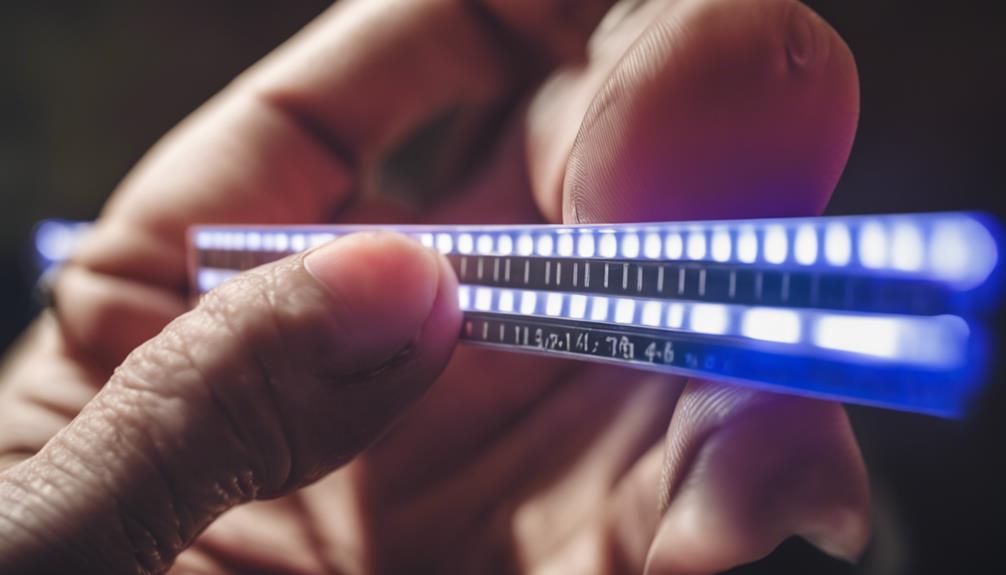
For precise measurement of the LED strip width, position the ruler or measuring tape perpendicular to the strip, aligning the starting point at one edge. By ensuring the ruler or measuring tape is straight, accuracy in measuring the LED strip width can be achieved.
When the opposite edge of the LED strip aligns with the ruler or measuring tape, read the measurement to determine the width. Record the measurement in millimeters or inches for reference when selecting accessories or determining compatibility with other components.
This straightforward method allows for a quick and reliable way to measure the LED strip width, aiding in making informed decisions regarding accessories and compatibility.
Whether working on a DIY project or a professional installation, using a ruler or measuring tape is a simple yet effective way to obtain the necessary measurements for a seamless lighting setup.
Measuring Width of LED Strip

When measuring the width of an LED strip, make sure to position the ruler or measuring tape perpendicular to the strip for accurate results. LED strip widths vary, with common sizes like 8mm, 10mm, and 12mm catering to different installation needs. For those seeking a slim design, the thinnest COB LED strip at 2.7mm offers a dotless light effect. Specific LED models such as 5050, 3528, and 2835 come in unique width dimensions, impacting energy consumption and brightness levels. Narrow strips are ideal for fitting into small spaces, while wider strips illuminate larger areas effectively. To understand the differences better, refer to the table below showcasing the width variations of popular LED strip models:
| LED Model | Width (mm) |
|---|---|
| 5050 | 10 |
| 3528 | 8 |
| 2835 | 6 |
Including Silicone Coating in Measurement
When measuring the width of LED strip lighting, it's essential to take into consideration the silicone coating that contributes to the overall dimensions. The silicone coating can increase the width by approximately 1-2mm, varying based on its thickness.
Considering this added width guarantees accurate measurements and proper selection of mounting accessories for practical applications.
Silicone Coating Impact
The addition of silicone coating to LED strip lighting can impact the overall width measurement by approximately 1-2mm. Including the silicone coating in the measurement guarantees precise sizing for installations. The silicone coating provides protection against dust, moisture, and physical damage, making the LED strips more durable and suitable for outdoor or harsh environments.
| Silicone Coating Impact | |
|---|---|
| Effect | Approx. Width Increase |
| Precise Sizing | 1-2mm |
| Protection | Dust, Moisture, Damage |
Measurement Accuracy Considerations
For accurate measurement accuracy considerations, it's vital to account for the impact of silicone coating on the width of LED strip lighting.
When measuring the LED strip width, it's essential to focus on the exposed width of the PCB board, excluding the silicone coating. Silicone coatings can add around 1-2mm to the overall width of the LED strip, impacting the accuracy of the measurement.
To guarantee precise dimensions, measure the exposed PCB width, considering the varying thickness of the silicone covering. For accuracy, take measurements at multiple points along the LED strip to accommodate any inconsistencies in the silicone coating.
When selecting accessories or mounting options for the LED strip lighting, factor in the variations caused by the silicone coating to avoid any misalignments.
Practical Application Insights
Considering the impact of silicone coating on LED strip lighting width, focusing on the exposed PCB width is essential for practical application insights. When dealing with LED strip width, it's important to take into account the PCB width to guarantee a proper fit during installation.
Here are some practical application insights to ponder:
- The silicone coating can increase the overall width by 1-2mm, affecting tight space installations.
- Accurate width measurement is essential for compatibility with connectors, channels, and diffusers.
- Exposed PCB width aids in selecting suitable mounting options to prevent light leakage.
- Understanding PCB width versus total width helps in choosing the right accessories.
- Careful consideration of these factors enhances the effectiveness of LED strip lighting setups.
Considering Waterproofing Material
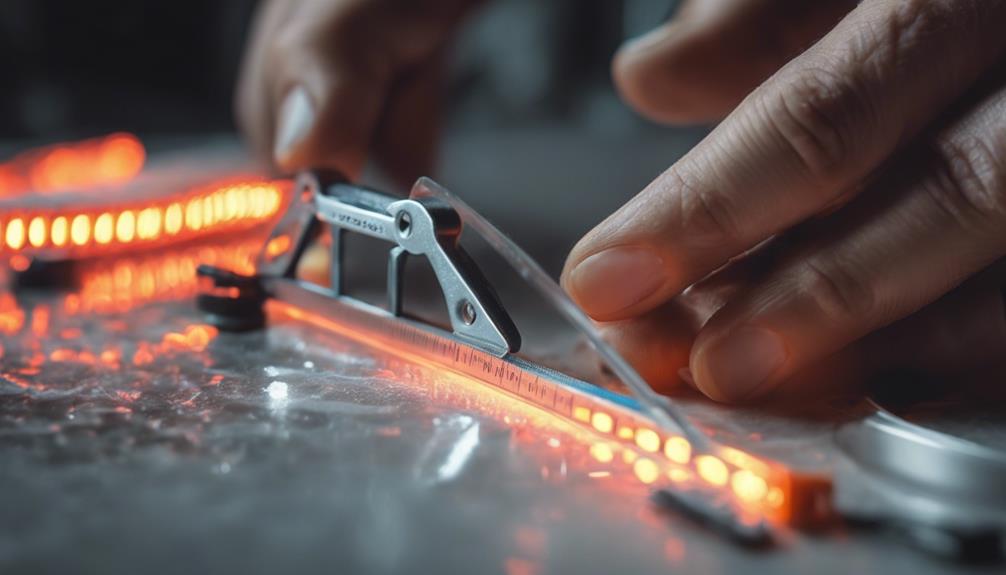
To enhance LED strip lights' durability and resistance to moisture, incorporating waterproofing material is vital. Common options for waterproofing LED strip lights include silicone coating, epoxy resin, and silicone sleeve covers. These materials add a protective layer that helps prevent damage from exposure to water or moisture. In outdoor environments or areas prone to dampness, waterproofing material plays an important role in maintaining the longevity and performance of LED strip lights.
Silicone sleeve covers are particularly convenient as they offer flexibility and ease of installation when encapsulating LED strips. Properly sealed waterproofing material guarantees the safety and functionality of LED strip lights in various conditions, making them suitable for both indoor and outdoor use. By choosing the right waterproofing material and applying it correctly, users can significantly extend the lifespan of their LED strip lights and enjoy consistent performance over time.
Accuracy in Measurement

How can one guarantee precise measurement of the width of LED strip lighting? To secure accuracy, follow these guidelines:
- Use a ruler or caliper to measure the width of the LED strip.
- Take measurements from edge to edge to capture the full width.
- Conduct multiple measurements along the LED strip length to check for variations.
- Refer to the manufacturer's specifications for the exact width of the LED strip.
- Accurate width measurement is essential for selecting compatible accessories such as aluminum channels and diffusers.
Determining Size for Installation Area

When determining the appropriate size for the installation area of LED strip lighting, start by measuring the width of the designated space using a ruler or measuring tape. It's important to make sure that the LED strip width aligns with the available space to prevent any fitting issues during installation.
Take into account the width of any accessories or channels required to house the LED strip for a seamless fit. Refer to the manufacturer's specifications or product descriptions to ascertain the exact width of the LED strip, ensuring compatibility with the installation area.
Accurate measurements of both the LED strip width and the installation area are essential for a successful and professional-looking installation. By carefully considering these factors and taking precise measurements, you can make sure that the LED strip fits perfectly within the designated space, creating a visually appealing and functional lighting setup.
Ensuring Precise Fit
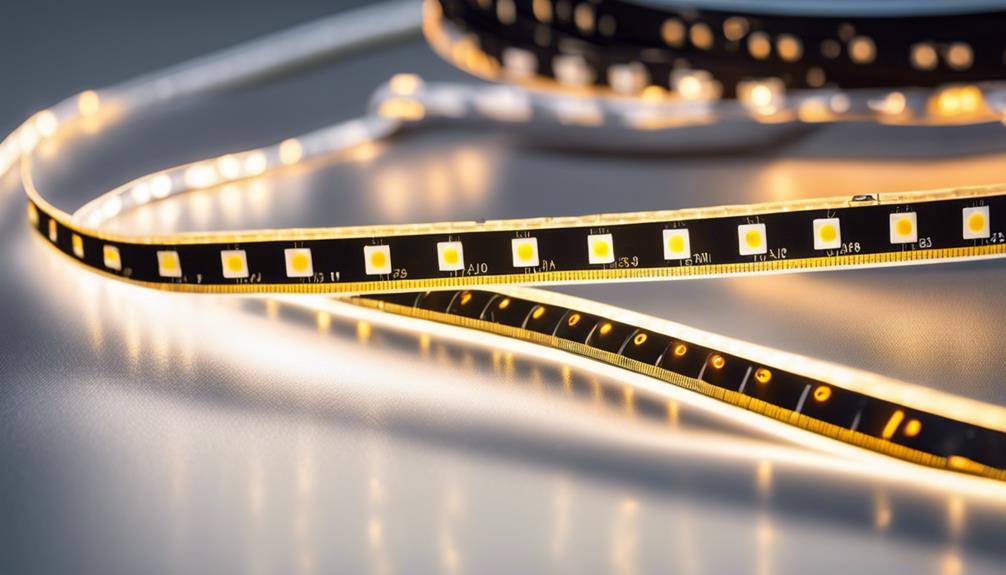
To guarantee a precise fit, it's vital to measure the LED strip accurately and consider cutting options. This helps in matching the strip's width with accessories and mounting solutions for a secure installation.
Measure Accurately for Fit
For a precise fit, accurately measuring the width of the LED strip is vital using a ruler or caliper. When measuring for fit, consider the width of the PCB as well as the LEDs themselves.
To guarantee compatibility with accessories such as aluminum channels or diffusers, take into account the full width of the LED strip. Double-check your measurements before cutting to avoid errors and guarantee a proper fit.
Understanding the exact width is essential for selecting connectors, power supplies, and mounting options. By paying attention to these details, you can make sure that your LED strip lighting fits perfectly and functions at its best.
Consider Cutting Options
Users can guarantee a precise fit for their LED strip lighting by considering various cutting options available to customize the length according to specific dimensions. LED strips can be cut at designated points, allowing for a tailored fit in different installations. This customization ensures that the LED strips align perfectly with the desired layout, creating a seamless and professional look.
Precise cutting is essential to maintaining the circuit's integrity and ensuring proper functionality. It's vital to follow manufacturer guidelines when cutting LED strips to prevent damage to the circuit and LED emitters. By utilizing cutting options effectively and adhering to recommended practices, users can achieve the desired length and fit for their LED strip lighting projects while maintaining excellent performance.
Importance of Proper Measurements
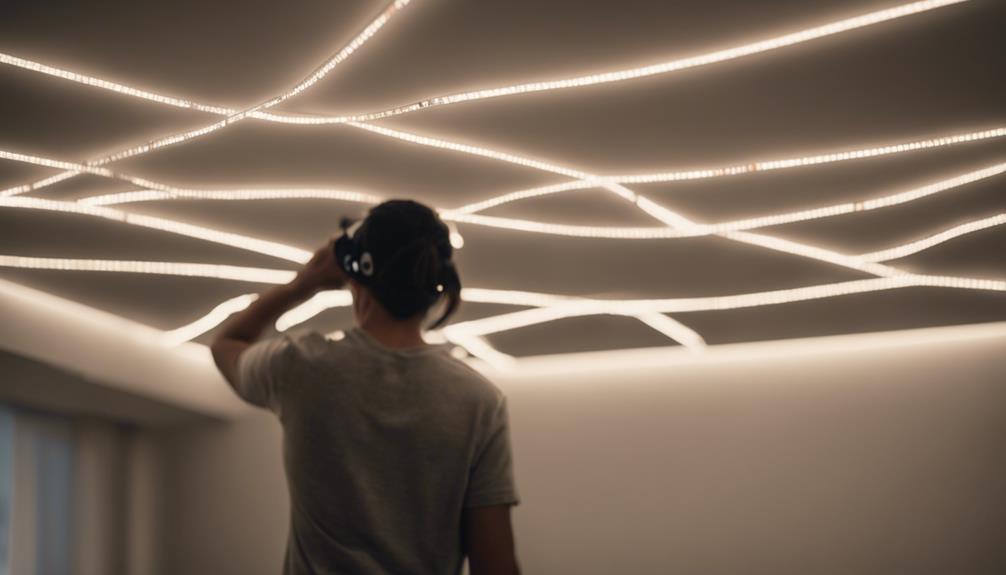
Ensuring proper measurements is essential for seamless installation and peak performance of LED strip lighting. Accurate measurements of the LED strip width are vital for a successful project. Here are five reasons why proper measurements matter:
- Compatibility: Proper measurements guarantee that the LED strip is compatible with accessories like aluminum channels.
- Secure Fit: Matching the LED strip width with the correct aluminum channel ensures a secure fit, preventing gaps or improper mounting.
- Professional Installation: Accurate width measurements are necessary for achieving a professional and polished installation.
- Performance: Correct measurements help in selecting the right LED strip for best performance.
- Aesthetics: Incorrect measurements can lead to visual flaws, affecting the overall look of the lighting setup.
Tips for LED Strip Lighting Project Success

To guarantee success in an LED strip lighting project, individuals should focus on the following key points:
- Using proper measuring techniques
- Selecting the correct tools
- Ensuring accurate dimensions
These factors play an essential role in achieving the best results and avoiding installation issues. By following these tips, one can navigate the project efficiently and effectively for a seamless outcome.
Proper Measuring Techniques
When measuring the width of LED strip lighting, precision is key for ensuring proper compatibility with accessories and connectors. To measure effectively, consider these tips:
- Use a digital caliper for accurate measurements.
- Measure the width at multiple points along the strip to account for any variance.
- Round up to the nearest millimeter for a secure fit.
- Take into account the width of the connectors when determining compatibility.
- Consider the type of channels or mounting surfaces where the LED strip will be placed for a seamless installation.
Choosing Correct Tools
For successful completion of an LED strip lighting project, having the correct tools is essential. To measure the LED strip width accurately, one should use a digital caliper or ruler with millimeter markings. Guarantee the LED strip is flat, then measure from one edge to the other for precise results. If unsure about the width, refer to the manufacturer's specifications as it can vary based on the type and model.
Taking multiple measurements along the strip length and averaging them can provide more accurate results, especially if the strip's width isn't uniform. This meticulous width measurement is vital for selecting the appropriate aluminum channel or mounting option for a seamless installation.
Ensuring Accurate Dimensions
Having the right tools for measuring the LED strip width is crucial for guaranteeing accurate dimensions in your lighting project. To achieve precision, consider these tips for success:
- Measure the actual width of the LED strip accurately using a ruler or caliper.
- Opt for LED strips with widths ranging from 8mm to 12mm based on your installation requirements.
- Confirm the LED strip width matches the aluminum channel or mounting surface for a secure fit.
- Consider the PCB width of single-color narrow LED lights, which can range from 3mm to 6mm.
- Choose the thinnest LED light strip, such as a 2.7mm wide COB LED strip, for applications requiring a slim profile.
Frequently Asked Questions
What Is the Width of LED Strip Lights?
LED strip lights come in various widths, ranging from 2.7mm for COB LED strips to wider options up to 120mm. Common widths include 8mm, 10mm, and 12mm, tailored to different installation needs.
The thinnest 2.7mm COB LED strip offers a dotless light effect with more integrated LEDs. Specific applications dictate the width choice, with narrow strips for small spaces and wider strips for larger projects.
Proper width selection guarantees fit, brightness, and uniformity in lighting design.
What Is the Width of LED Strip?
LED strip lighting typically ranges in width from 8mm to 12mm, catering to various lighting needs. However, specialized versions like COB technology can offer ultra-thin options as narrow as 2.7mm for a sleek design.
Different types such as 5050, 3528, and 2835 vary in width from 3.5mm to 10mm. Selecting the appropriate width is important to guarantee peak performance and coverage based on the specific lighting requirements.
What Is the Width of 3528 LED Strips?
The width of 3528 LED strips ranges from 3.5mm to 28mm, offering versatility in various lighting applications. These LEDs consume around 0.08 watts per LED, making them energy-efficient compared to other types.
Known for their brightness, 3528 LEDs provide high output in a compact form. Different width options cater to diverse lighting needs and installation preferences.
The thinnest 3528 LED strip, at 3.5mm, is ideal for discreet or compact lighting setups.
How Are LED Sizes Measured?
LED sizes are typically measured in millimeters, like 5050 LEDs being 5mm by 5mm. The dimensions of LED strip lighting are determined by the width of the PCB (Printed Circuit Board) where the LEDs are mounted.
Specific types such as 3528 and 2835 have distinct LED dimensions that influence overall strip width. These variations accommodate diverse applications and installation needs.
Understanding LED sizes is essential for selecting the appropriate lighting solution for specific projects.
Conclusion
To sum up, measuring the width of LED strip lighting is essential for a successful installation project. By following the outlined steps and taking accurate measurements, you can guarantee a precise fit and achieve the desired lighting effect.
While some may find the process of measuring tedious, the significance of proper measurements can't be overstated in achieving a seamless and professional look for your LED strip lighting setup.
Lighting
LED Lights for Aquariums: Are They Beneficial?
Explore with us the perks of LED lights for your aquatic pals! Discover if are led lights good- for aquariums and how they can enhance your tank’s beauty.
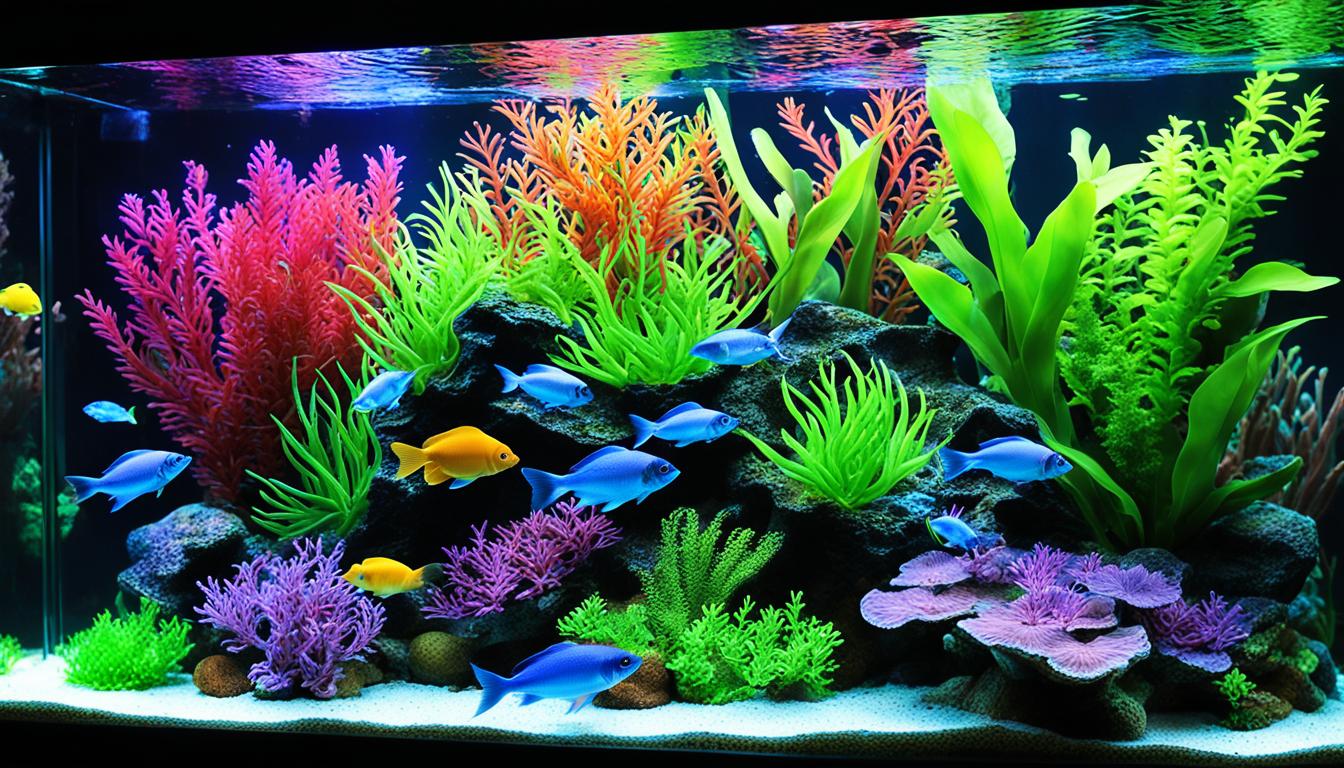
Welcome to our guide on LED lights for aquariums! If you’re a fish enthusiast or an avid aquarium hobbyist, you may be wondering if LED lights are truly beneficial for your underwater ecosystem. Do they offer more than just lighting? Can they enhance the growth of plants and bring out the brilliant colors of your fish? Today, we’ll delve into the world of LED lighting and explore the numerous advantages they bring to your aquarium.
Key Takeaways:
- LED lights provide energy savings, vibrant color effects, and a long lifespan for your aquarium.
- They come in various color spectrums, allowing for customized lighting options.
- Dimming capabilities in LED lights can adjust brightness and create blending effects.
- Proper ventilation is important to maintain the performance and lifespan of LED lights.
- LED lighting can enhance coral growth and bring out the beautiful colors in fish.
The Benefits of LED Lighting for Aquariums
LED lighting offers several benefits for aquariums. Not only do they provide energy savings, but they also enhance the visual appeal of your tank with vibrant colors and shimmer effects. LEDs have a long lifespan, lasting up to 50,000 hours, which means you won’t have to replace them frequently. The ability to dim LEDs allows you to adjust brightness and create different lighting effects, giving you full control over the atmosphere in your aquarium.
Proper ventilation is crucial when using LED lighting to keep them cool and maintain their performance over time. By promoting coral growth and bringing out the colors in your fish, LED lights create a captivating and dynamic underwater environment.
In addition to the aesthetic benefits, LED lighting is a cost-effective choice for aquariums. Compared to traditional lighting options, LEDs consume less energy and can save you money on electricity costs in the long run. Their efficiency and longevity make them an excellent investment for any aquarium enthusiast.
Overall, LED lighting offers a visually appealing, customizable, and cost-effective solution for enhancing the beauty of your aquarium. Let’s explore the different factors to consider when choosing the right LED lights for your specific needs.
| Benefits | LED Lighting | Traditional Lighting |
|---|---|---|
| Energy Efficiency | ✓ | ✗ |
| Long Lifespan | ✓ | ✗ |
| Customizability | ✓ | ✗ |
| Cooler Operation | ✓ | ✗ |
| Aquarium Aesthetics | ✓ | ✗ |
| Cost Savings | ✓ | ✗ |
Choosing the Right LED Lights for Your Aquarium
When it comes to selecting LED lights for your aquarium, several factors should be taken into consideration. These factors include the color spectrum, light intensity, and light spread of the LED lights. By understanding these aspects, you can choose LED lights that are best suited for your aquarium’s unique needs and create an optimal environment for your aquatic companions.
Color Spectrum
The color spectrum of LED lights plays a crucial role in enhancing the visual appeal of your aquarium. LED lights are available in various color options, such as warm white, cool white, blue, and red. Each color spectrum can have a different effect on the colors of your fish and plants. It’s important to choose LED lights that complement the natural colors and patterns of your aquatic life, creating a vibrant and captivating underwater display.
Light Intensity
The light intensity of LED lights refers to the brightness or luminosity they emit. Different plants have varying light intensity requirements for optimal growth. Low light plants, such as Anubias and Java Moss, thrive in environments with lower light intensity. On the other hand, high light plants like Amazon Sword and Dwarf Baby Tears require more intense lighting, often paired with carbon dioxide injection. Consider the plant species you intend to keep and select LED lights with the appropriate light intensity to promote healthy growth.
Light Spread
Light spread is another important consideration when choosing LED lights for your aquarium. It refers to how evenly the light is distributed throughout the tank. Each part of the aquarium, including the substrate and background, should receive sufficient light to support the growth of both plants and aquatic life. LED lights with a wide light spread ensure that all areas of the aquarium are adequately illuminated, promoting balanced growth and enhancing the overall aesthetic appeal of the tank.
LED lights offer a great deal of flexibility in terms of color spectrum, light intensity, and light spread. This versatility allows you to customize your aquarium’s lighting to meet the specific needs of your aquatic ecosystem. By carefully considering these factors and selecting LED lights that align with your aquarium’s requirements, you can create a visually stunning and thriving underwater world for your fish and plants.
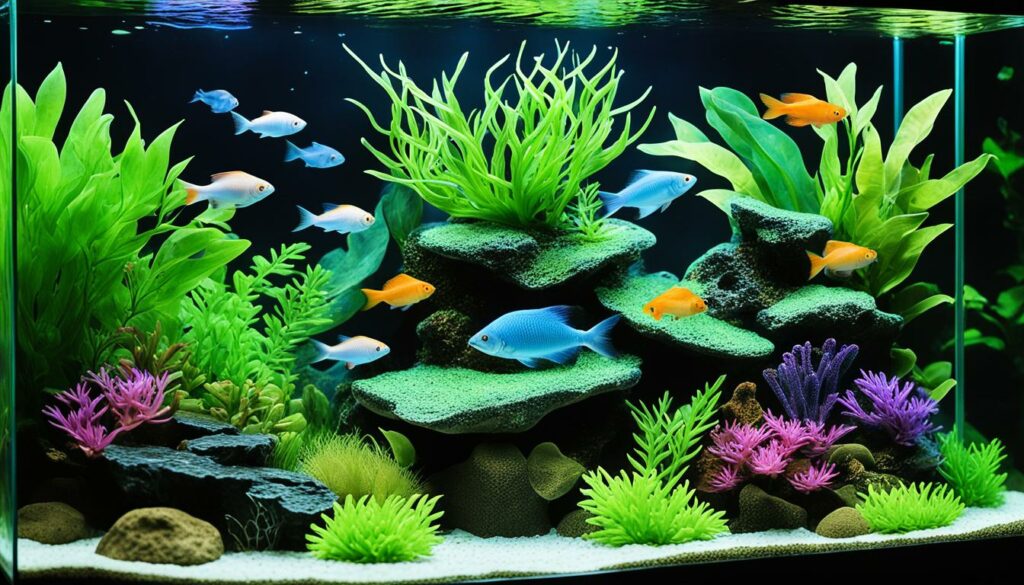
| Factor | Considerations |
|---|---|
| Color Spectrum | Choose LED lights that enhance the colors of your fish and plants. |
| Light Intensity | Consider the light intensity requirements of your plant species for optimal growth. |
| Light Spread | Ensure all areas of the aquarium receive sufficient light for balanced growth. |
The Advantages of LED Lights for Freshwater Aquariums
LED lights have several advantages for freshwater aquariums. Firstly, they consume less energy compared to traditional lighting options, resulting in cost savings for aquarium owners. This is especially beneficial for aquariums that require lighting for long periods throughout the day. LED lights are highly energy-efficient, converting a higher percentage of electricity into visible light, making them a sustainable lighting choice.
Another advantage is that LED lights produce less heat compared to other lighting options. This is crucial for maintaining the optimal temperature of the aquarium water and preventing overheating. LED lights emit significantly less heat, reducing the risk of stressing or harming the aquatic inhabitants.
LED lights also have a significantly longer lifespan compared to traditional lighting options. On average, LED lights can last up to 50,000 hours, eliminating the need for frequent bulb replacements. This not only saves money but also reduces the hassle of constantly changing bulbs and ensures consistent lighting for the aquarium.
One of the key advantages of LED lights is their ability to be dimmed and programmed. This allows aquarium owners to customize the lighting effects according to their preferences and mimic natural daylight cycles. Dimming the lights can create a calming ambiance, especially during nighttime, providing a more natural habitat for the aquatic life. Programming the lights to change intensities or colors throughout the day can also create visually engaging effects and enhance the overall aesthetic appeal of the aquarium.
LED lights are available in a variety of colors, allowing aquarium owners to accentuate different aspects of the tank. Whether it’s highlighting the vibrant colors of the fish or creating a specific ambiance with colored lighting, LED lights offer versatility in terms of color options.
Furthermore, LED lights provide broad coverage, ensuring all parts of the aquarium receive sufficient light. This is important for promoting healthy plant growth in freshwater aquariums and ensuring that no areas are left in shadow. With LED lights, you can create an evenly lit environment for both the fish and the plants, enhancing the overall visual appeal of the aquarium.
Overall, LED lights offer numerous advantages for freshwater aquariums, including energy efficiency, reduced heat output, long lifespan, customizable lighting effects, color options, and broad coverage. These advantages make LED lighting an excellent choice for aquarium owners who want to create an efficient, visually appealing, and healthy environment for their aquatic pets.
Factors to Consider When Choosing LED Lights for Planted Aquariums
Choosing the right LED lights for your planted aquarium is crucial to ensure optimal growth and health of your underwater plants. There are several key factors that you should consider when making your selection:
1. Color Spectrum
The color spectrum of the LED lights plays a significant role in promoting photosynthesis and plant growth. Neutral white lights with color temperatures ranging from 5000 to 6500 K are often preferred for planted aquariums as they closely simulate natural daylight. This range provides the sufficient light wavelengths needed for chlorophyll absorption and ensures that your aquatic plants receive the right amount of light energy.
2. Light Intensity
The light intensity required depends on the types of plants you intend to cultivate in your aquarium. Low light plants, such as Java Fern and Anubias, are ideal for beginner-friendly setups and require lower light intensity. On the other hand, high light plants like Carpeting Dwarf Hairgrass and Ludwigia require higher light intensity and may necessitate the use of CO2 injection systems. Consider the light intensity requirements of your chosen plants to ensure they receive adequate light for healthy photosynthesis.
3. Light Spread
Light spread refers to how far the light emitted by the LED fixtures reaches within the aquarium. It is important to choose LED lights with a wide light spread to ensure that all areas of your planted aquarium receive sufficient light. This is particularly important for larger tanks as they require a higher light spread to cover the entire surface area effectively. Adequate light spread prevents uneven growth and ensures that all your plants receive consistent illumination.
Our Recommendation:
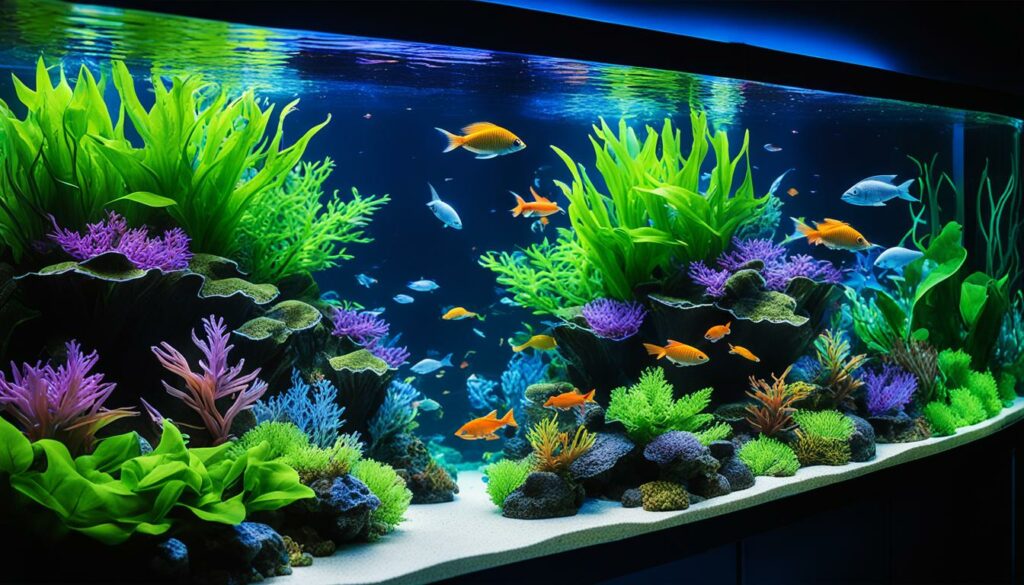 For those seeking a reliable LED light option for planted aquariums, we recommend the Finnex Planted+ 24/7 LED Aquarium Light. This LED light fixture offers a wide color spectrum, adjustable light intensity, and an even light spread, making it ideal for nurturing a variety of aquatic plants. The Finnex Planted+ 24/7 also features a convenient 24-hour lighting cycle with customizable settings, allowing you to simulate natural daylight and improve the health and vibrancy of your plants.
For those seeking a reliable LED light option for planted aquariums, we recommend the Finnex Planted+ 24/7 LED Aquarium Light. This LED light fixture offers a wide color spectrum, adjustable light intensity, and an even light spread, making it ideal for nurturing a variety of aquatic plants. The Finnex Planted+ 24/7 also features a convenient 24-hour lighting cycle with customizable settings, allowing you to simulate natural daylight and improve the health and vibrancy of your plants.
Consider the factors mentioned above when choosing LED lights for your planted aquarium to create a thriving underwater oasis for your aquatic plants.
Pros and Cons of LED Lighting for Freshwater Aquariums
LED lighting for freshwater aquariums offers several advantages that make it a popular choice among aquarium enthusiasts. However, it also has some limitations to consider. Let’s take a closer look at the pros and cons of LED lighting for freshwater aquariums.
Pros of LED Lighting for Freshwater Aquariums:
- Low energy consumption: LED lights are highly energy-efficient, consuming less electricity compared to traditional lighting options. This not only reduces your electricity bills but also minimizes your environmental impact.
- Low heat output: LED lights generate minimal heat, reducing the risk of overheating the aquarium and affecting the water temperature. This creates a more stable and comfortable environment for your aquatic pets.
- Long lifespan: LED lights have an impressive lifespan, lasting up to 50,000 hours or more. This means you won’t need to replace bulbs frequently, saving you money in the long run.
- Adjustable light intensity: LED lights allow you to adjust the brightness and create different lighting effects. This flexibility enables you to provide the ideal lighting conditions for your plants, fish, and overall aesthetic preferences.
- Various color options: LED lights come in a wide range of colors, allowing you to customize the lighting scheme for your aquarium. This can enhance the visual appeal of your tank and highlight the vibrant colors of your fish and plants.
Cons of LED Lighting for Freshwater Aquariums:
- Higher initial cost: LED fixtures may have a higher upfront cost compared to traditional lighting options. However, the long-term energy savings and extended lifespan of LEDs offset the initial investment.
- Limitations for high-light planted aquariums: Some LED lighting fixtures may have limitations for high-light planted aquariums that require intense lighting conditions. It’s essential to choose LED lights that can provide the necessary light intensity for your specific plant species.
Despite these limitations, LED lighting remains a popular choice for freshwater aquariums due to its energy efficiency, longevity, and customizable features. By carefully considering the specific needs of your aquarium and choosing the right LED lighting setup, you can enjoy the benefits of LED lighting while creating a visually stunning and thriving aquatic environment.
| Pros | Cons |
|---|---|
| Low energy consumption | Higher initial cost |
| Low heat output | Limitations for high-light planted aquariums |
| Long lifespan | |
| Adjustable light intensity | |
| Various color options |
While there are some drawbacks to consider, the benefits of LED lighting for freshwater aquariums make it a worthwhile investment. With energy savings, long lifespan, and customizable features, LED lighting can enhance the beauty and health of your aquatic ecosystem.
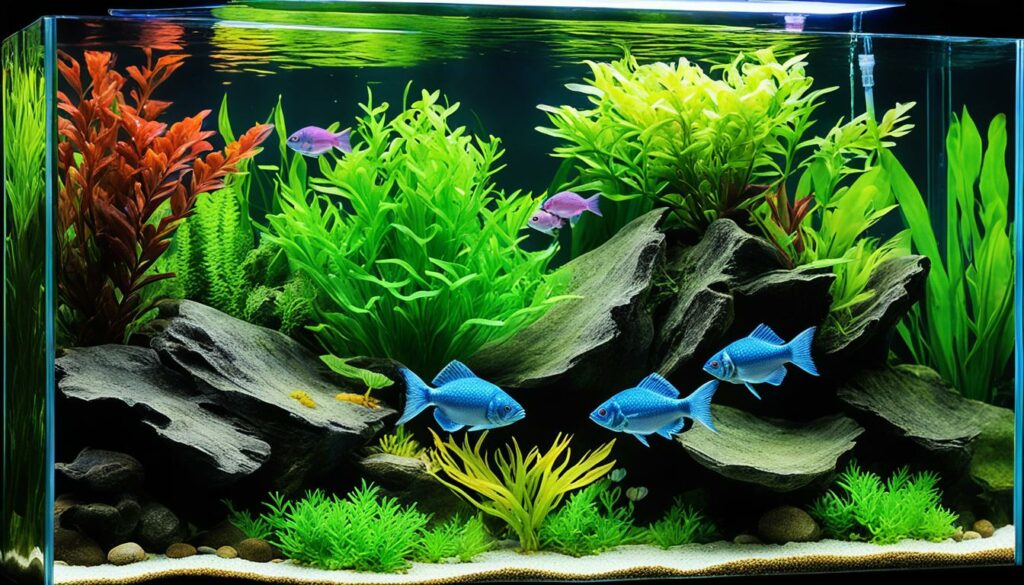
Understanding Color Spectrum and Light Intensity in LED Lighting for Aquariums
Color spectrum and light intensity play crucial roles in achieving optimal lighting conditions for aquariums with LED lighting. The color spectrum refers to the range of colors produced by the light, while light intensity determines the brightness level. Understanding these factors is essential for creating the perfect environment for your aquatic plants and fish.
When it comes to the color spectrum, many hobbyists prefer neutral white lights in the 5000 to 6500 K range. These lights simulate natural daylight, which is ideal for plant growth and enhances the colors of your fish and plants. The neutral white spectrum provides a balanced and visually appealing aesthetic to your aquarium.
Light intensity, measured in PAR (Photosynthetically Active Radiation), is another key consideration. Different plants have varying light intensity requirements. For beginners or low-light plants, a lower light intensity is suitable. On the other hand, high-light plants require more intense lighting. It’s essential to strike a balance between providing enough light for plant growth and avoiding excessive light that can lead to algae growth.
LED lighting offers the flexibility to adjust both color spectrum and light intensity to meet the specific needs of your aquarium. This ability to tailor the lighting conditions allows you to create an environment that promotes healthy plant growth while showcasing the vibrant colors of your fish.
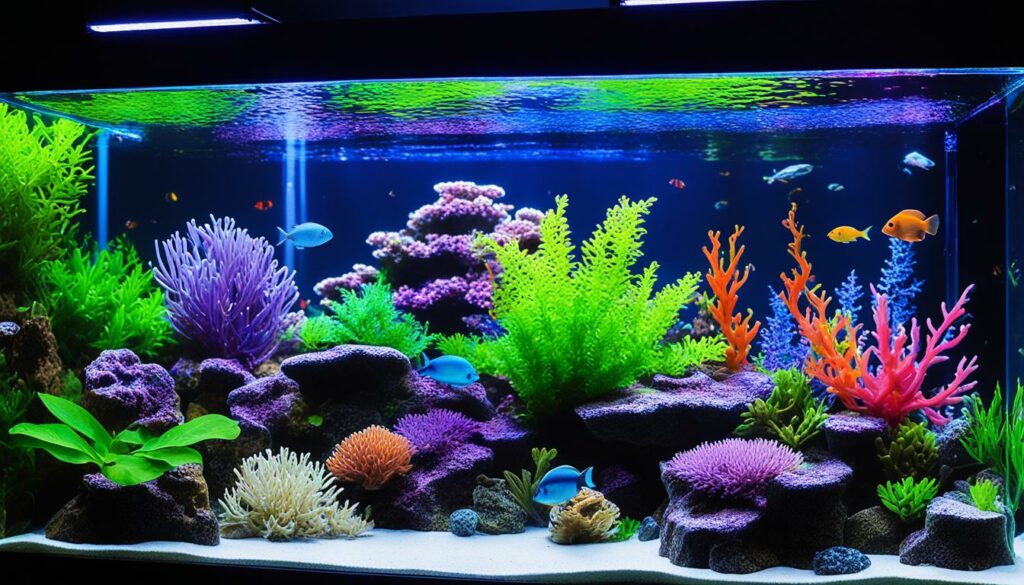
“LED lighting allows us to fine-tune the color spectrum and light intensity to create an optimal environment for our aquatic plants and fish.”
The Importance of Light Spread in LED Lighting for Aquariums
When it comes to LED lighting for aquariums, one crucial factor to consider is light spread. Light spread refers to how far the light reaches in the tank, ensuring that all parts of the aquarium receive sufficient light. Proper light spread is essential for creating an optimal environment for your aquatic life and enhancing the overall visual aesthetics of the tank.
Most LED lights have a light spread of around 1 foot directly beneath them. While this may be adequate for smaller tanks, larger aquariums may require multiple lights or a high-quality LED light with a wider light spread. It’s important to take the dimensions of your aquarium into account when choosing LED lights to ensure that every corner of the tank is adequately illuminated.
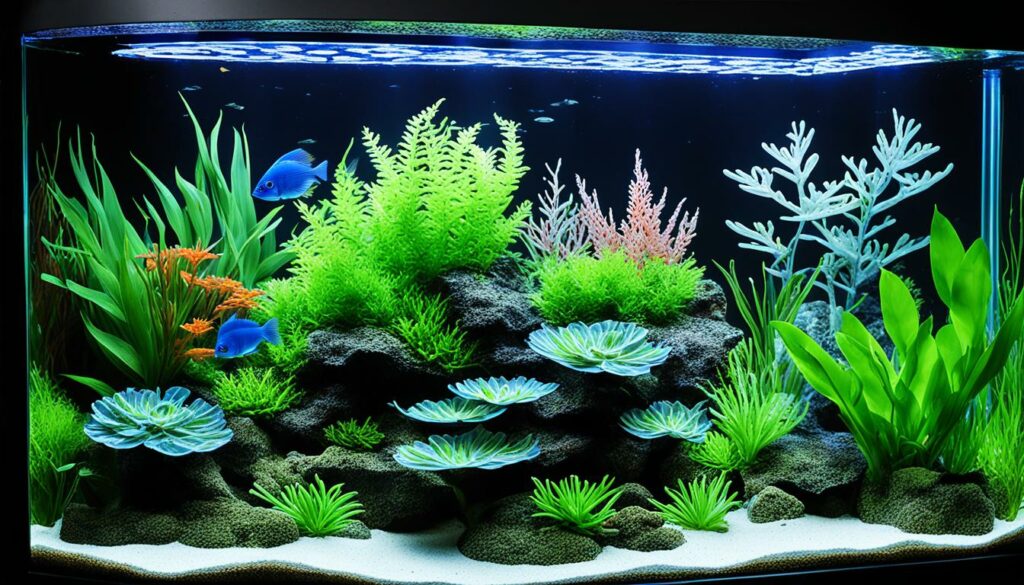
Why is light spread so important? Well, it directly affects the growth and health of the plants in your aquarium. Plants require sufficient light to undergo photosynthesis, which is crucial for their growth and survival. Proper light spread ensures that all plants receive the light they need to thrive, preventing any areas of shadow or insufficient illumination.
Additionally, light spread plays a significant role in the visual appeal of your aquarium. Adequate lighting coverage allows the vibrant colors of your fish and plants to shine through, creating a stunning and captivating display. It helps to create depth and dimension in the tank, making it visually pleasing and aesthetically appealing.
Tips for Achieving Optimal Light Spread:
- Consider the size and dimensions of your aquarium when choosing LED lights. Ensure that the light fixtures can adequately cover the entire tank.
- For larger aquariums, opt for LED lights with a wider light spread or consider using multiple lights strategically placed to evenly distribute the light.
- Ensure that the chosen LED lights have adjustable mounting options to allow for proper positioning and angle adjustment to achieve uniform light distribution.
- Regularly monitor the light distribution within the tank and make any necessary adjustments to ensure optimal coverage.
In conclusion, understanding the importance of light spread in LED lighting for aquariums is crucial for creating a thriving and visually appealing aquatic environment. By choosing LED lights with the right light spread and ensuring proper coverage, you can provide the ideal lighting conditions for your fish and plants to flourish.
Choosing the Best LED Aquarium Light: A Recommendation
After careful evaluation, we recommend the Aquarium Co-Op Easy Plant LED as the best LED aquarium light option. This light strikes the perfect balance between simplicity, affordability, and performance, making it an excellent choice for both beginner and experienced aquarium enthusiasts.
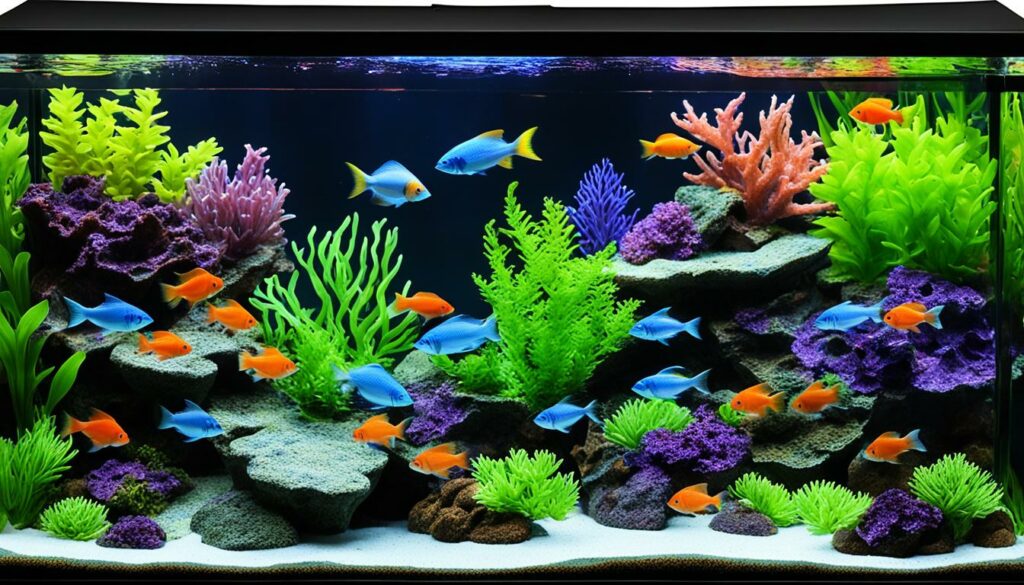
The Aquarium Co-Op Easy Plant LED features a color spectrum of 5300 K, which closely resembles natural sunlight. This spectrum enhances the vibrant colors of your fish and plants, creating a visually stunning underwater environment. Whether you have a freshwater or planted aquarium, this light will beautifully showcase your aquatic inhabitants.
One of the standout features of the Aquarium Co-Op Easy Plant LED is its exceptional quality. It comes with a 3-year warranty, providing peace of mind and a guarantee of long-lasting performance. The light is also IP67 water-resistant and has ETL certification for safety standards, ensuring a reliable and secure lighting solution for your aquarium.
With adjustable brightness capabilities, this LED light caters to the needs of both low light and high light plants. You can easily customize the light intensity to promote healthy plant growth and create the desired ambiance in your aquarium.
In addition to its performance, the Aquarium Co-Op Easy Plant LED is designed with energy efficiency in mind. The power-efficient LEDs consume less electricity, resulting in cost savings on your energy bills. The housing design effectively dissipates heat, keeping the light cool and prolonging its lifespan.
For added convenience, the Aquarium Co-Op Easy Plant LED comes with a 12-foot power cable. This flexibility allows you to easily reach wall outlets and set up your aquarium lighting system according to your specific needs.
The Aquarium Co-Op Easy Plant LED is a reliable and high-quality LED aquarium light that offers exceptional performance while remaining budget-friendly. It ticks all the boxes you’d expect in a top-notch lighting solution, making it our top recommendation for anyone in search of the best LED aquarium light.
Conclusion
LED lights are highly beneficial for aquariums, providing energy savings, vibrant color effects, and a long lifespan. Their versatility in terms of color spectrum, light intensity, and light spread makes them an excellent choice for various aquarium setups. Planted aquariums especially benefit from LED lights as they support plant growth and enhance the visual appeal of the tank.
When selecting LED lights, it is important to consider factors such as color spectrum, light intensity, and light spread to ensure they meet the specific needs of your aquarium. The right LED lights can bring out the beauty of your fish and plants while providing the optimal lighting conditions for their growth.
If you’re looking for a recommended LED light option that combines simplicity, affordability, and performance, we suggest considering the Aquarium Co-Op Easy Plant LED. With its 5300 K color spectrum, adjustable brightness, and energy-efficient design, it offers everything you need to enhance the beauty of your aquarium. Embrace the benefits of LED lighting and create a stunning underwater oasis in your home.
FAQ
What are the benefits of LED lighting for aquariums?
What factors should I consider when choosing LED lights for my aquarium?
What are the advantages of LED lights for freshwater aquariums?
What factors should I consider when choosing LED lights for planted aquariums?
Are there any drawbacks to using LED lighting for freshwater aquariums?
What is the importance of color spectrum and light intensity in LED lighting for aquariums?
Why is light spread important in LED lighting for aquariums?
Can you recommend a good LED aquarium light?
Vivienne – Your Content Companion Vivienne is your content companion, curating valuable tips, advice, and inspiration to guide you on your home decor journey. From insightful blog posts to informative product descriptions, she’s here to empower you with the knowledge you need to create your dream space.
Lighting
Will Plants Grow Under LED Lighting?
Plants flourish under LED lighting, receiving essential red and blue light for growth—uncover how LED lights revolutionize indoor gardening.
Plants thrive well under LED lighting as it emits essential red and blue light important for growth and photosynthesis. LED grow lights efficiently provide the light intensity needed for indoor plants to flourish, typically ranging from 1000-1500 lux. Their customizable features accommodate various plant species, enhancing growth stages. Studies show plants respond favorably to LED lights, growing faster and taller. Energy-efficient and cost-effective, LED lights simulate natural sunlight, supporting healthy indoor plant development. Discover more about how LED grow lights revolutionize indoor gardening and promote ideal plant growth.
Key Takeaways
- LED lighting provides essential red and blue spectrums for plant growth.
- Plants thrive under LED lights with 1000-1500 lux light intensity.
- Customizable LED options cater to different plant species' unique light requirements.
- Studies demonstrate increased height and growth rates in plants under LED lighting.
- Energy-efficient LED grow lights support healthy plant development indoors.
Understanding Plant Light Requirements
Indoor plants thrive when exposed to specific light spectrums like blue and red, essential for growth under LED lighting. LED grow lights efficiently emit these necessary light spectrums, promoting ideal plant growth. Most indoor plants require 1000-1500 lux of light intensity to thrive, a range easily achievable with LED lighting setups. The ability to customize LED grow lights allows for precise adjustments to meet the unique light requirements of different plant species.
LED lights offer a longer lifespan compared to traditional lighting options, making them a cost-effective and sustainable choice for indoor gardening. Understanding the photoperiod, or the duration of light exposure, is important as it varies among plant species. By providing the right balance of blue and red light spectrums, LED grow lights ensure that plants receive the necessary energy for photosynthesis and overall growth.
To conclude, LED lighting plays a significant role in providing the specific light spectrums essential for indoor plants to thrive and reach their full growth potential.
The Science Behind LED Grow Lights
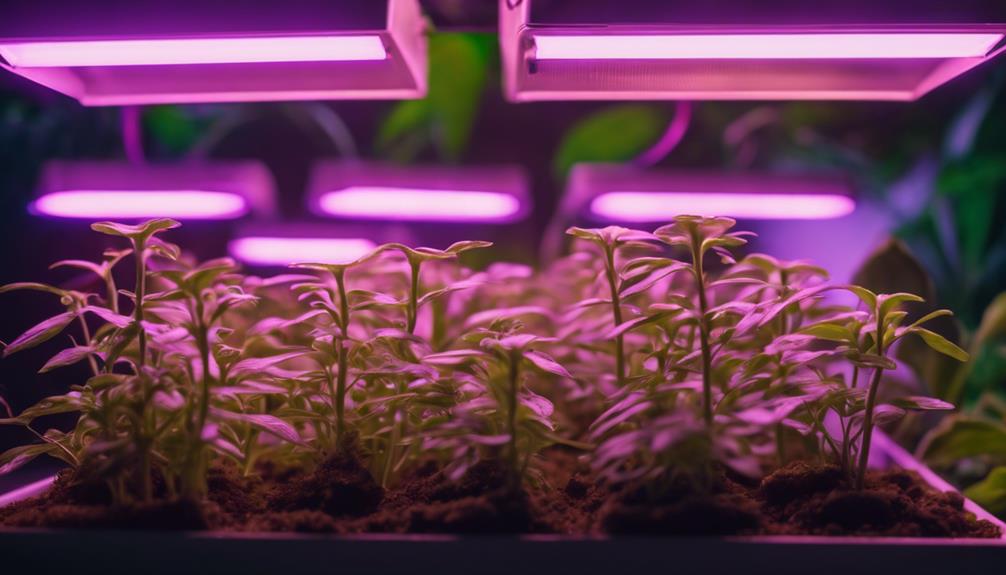
LED grow lights are designed to emit specific red and blue spectrums essential for plant growth. The efficient light intensity provided by LEDs, typically 1000-1500 lux, contributes to plants thriving under this lighting.
LED grow lights can be customized to meet the specific light requirements of different plant species.
Light Spectrum Efficiency
Efficiently emitting specific light spectrums essential for plant growth, LED grow lights revolutionize indoor gardening with their tailored spectrum customization. LED grow lights are designed to provide plants with the most efficient light spectrum efficiency they need to thrive.
By emitting targeted wavelengths of red and blue light, these lights closely mimic the natural sunlight that plants require for photosynthesis. Studies by NASA have shown that plants respond exceptionally well to LED lighting, growing faster and taller compared to traditional light sources.
The customizable spectrum of LED grow lights allows for different light intensities to support various growth stages of plants. Not only are LED grow lights energy-efficient and cost-effective, but they also play a crucial role in promoting healthy plant growth indoors.
Plant Growth Benefits
How do plants benefit from the specific blue and red light spectrums emitted by LED grow lights for their growth and photosynthesis?
LED grow lights offer a complete spectrum of light that includes these essential wavelengths, promoting ideal photosynthesis and overall plant development.
By providing the necessary light intensity and spectrum, LED grow lights support plants in thriving indoors.
The customizable options, such as blurple, white, and COB lights, cater to different growth stages, ensuring plants receive the specific light they need for each phase.
Studies, including those conducted by NASA, have demonstrated that plants grown under LED lights exhibit increased height and growth rates compared to other lighting sources.
This makes LED grow lights a preferred choice for indoor plant growth, offering energy efficiency, cost-effectiveness, and longevity.
Energy Consumption Comparison
Comparing energy consumption between LED grow lights and traditional lighting options reveals a significant advantage in favor of LED technology. LED grow lights consume up to 50% less energy than traditional options, showcasing their superior energy efficiency.
This efficiency not only reduces energy costs but also lessens the environmental impact of lighting systems. LED lights excel at converting energy into light, making them a sustainable choice for indoor plant growth.
The lower energy consumption of LED lights translates into cost savings over time, making them an economically viable option. Additionally, as LED lighting technology continues to advance, further improvements in energy efficiency are expected, solidifying LED grow lights as a top choice for energy-conscious indoor gardening enthusiasts.
Types of LED Grow Lights
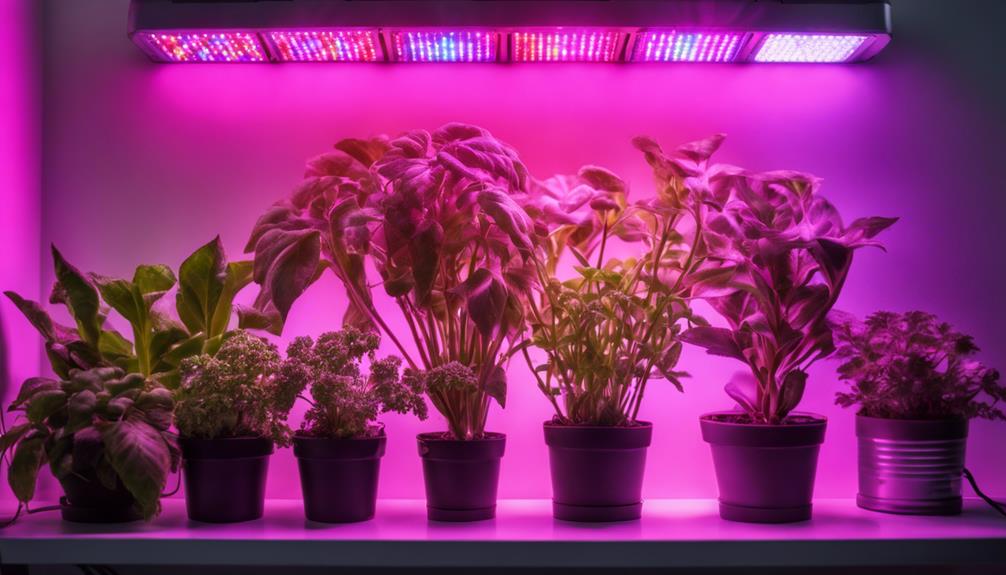
Different types of LED grow lights, such as Full-Spectrum, Blurple, White, and COB LEDs, cater to various plant requirements. Full-Spectrum LEDs provide a wide range of light beneficial for all growth stages, closely mimicking natural sunlight. White LEDs offer a balanced spectrum that promotes overall plant health and is ideal for visual inspection. Blurple LEDs, a mix of blue and red lights, are excellent for flowering and fruiting stages due to their targeted spectrum. COB LEDs, with multiple chips in one module, offer high intensity and are suitable for larger growing areas. These LED lights are energy-efficient, emit low heat, and can be customized for specific plant needs. The table below summarizes the key characteristics of each type:
| LED Type | Description | Ideal Growth Stage |
|---|---|---|
| Full-Spectrum | Wide light range mimicking sunlight, suitable for all growth stages | Germination, Growth, Flower |
| White | Balanced spectrum promoting overall plant health, ideal for visual inspection | General plant health |
| Blurple | Mix of blue and red lights, great for flowering and fruiting stages | Flowering, Fruiting |
| COB | High intensity with multiple chips, suitable for larger growing areas | Larger growing areas |
LED grow lights offer versatility and efficiency, making them a popular choice for indoor plant cultivation.
Benefits of Using LED Grow Lights
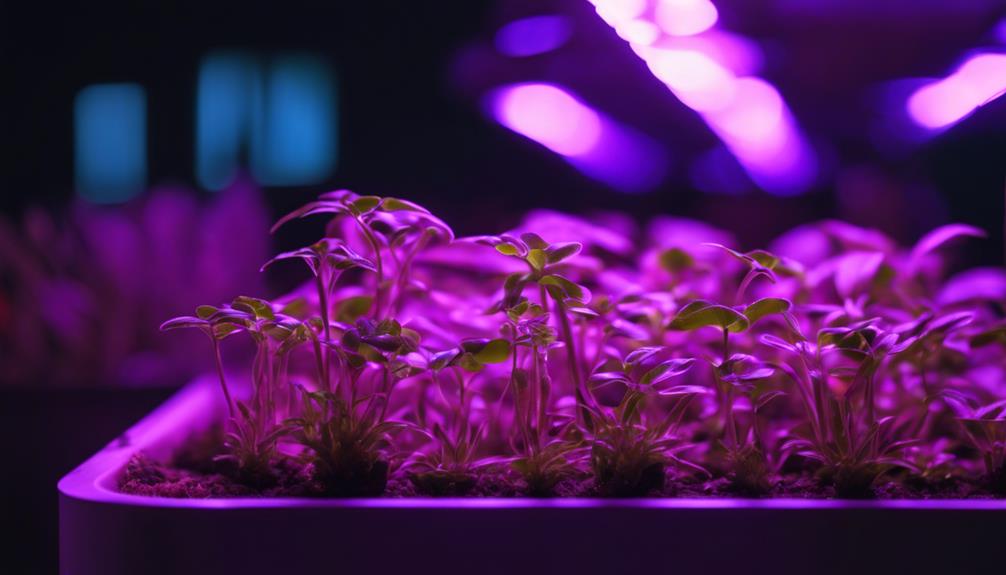
LED grow lights are an energy-efficient lighting option that promotes plant growth by emitting a well-suited light spectrum. These lights have a longer lifespan and offer customizable spectrum options to cater to different plant growth stages.
Studies, including those conducted by NASA, have shown that plants grow taller and faster under LED lights.
Energy-Efficient Lighting Option
Using LED grow lights provides an energy-efficient lighting option for indoor gardening, offering numerous benefits for plant growth. LED lights are known for being energy efficient, consuming less power than traditional grow lights while still providing ideal light for plants. They also have a longer lifespan, reducing the need for frequent replacements and saving on maintenance costs in the long run.
Another advantage of LED grow lights is their minimal heat emission, which prevents damage to plants and allows for closer placement without the risk of burning. Additionally, these lights offer a customizable spectrum, enabling users to adjust the light output based on specific plant needs and growth stages.
Studies have shown that plants grow taller and faster under LED lights, making them a reliable choice for indoor gardening.
Optimal Light Spectrum
Providing plants with the ideal light spectrum is essential for maximizing their growth potential indoors. LED grow lights offer a range of benefits for plant growth, including:
- LEDs provide the necessary red and blue light spectrums for best plant growth.
- They offer customizable spectrums to cater to different plant requirements.
- NASA studies demonstrate that plants grow taller and faster under LED lights, showcasing their effectiveness.
- LED lights are energy-efficient and cost-effective compared to traditional grow lights.
- Plants require specific light spectrums like white, red, and blue for growth, flowering, and fruit production, all of which LED grow lights can provide.
Promotes Plant Growth
Enhancing plant growth and well-being, LED grow lights promote healthy development through their specific red and blue light spectrums. These lights are tailored to meet the precise needs of plants, stimulating photosynthesis and overall growth.
Compared to traditional lighting, LED lights encourage plants to grow taller and quicker, showcasing their effectiveness in supporting plant vitality. Additionally, the energy-efficient nature of LED lights not only benefits the environment but also makes them a cost-effective option for promoting plant growth.
NASA studies further validate the positive impact of LED lights on plant productivity, emphasizing their significance in agriculture and horticulture. With customizable spectrums available for different growth stages, LED grow lights provide ideal conditions for plants to thrive and reach their full potential.
Tips for Using LED Grow Lights Effectively
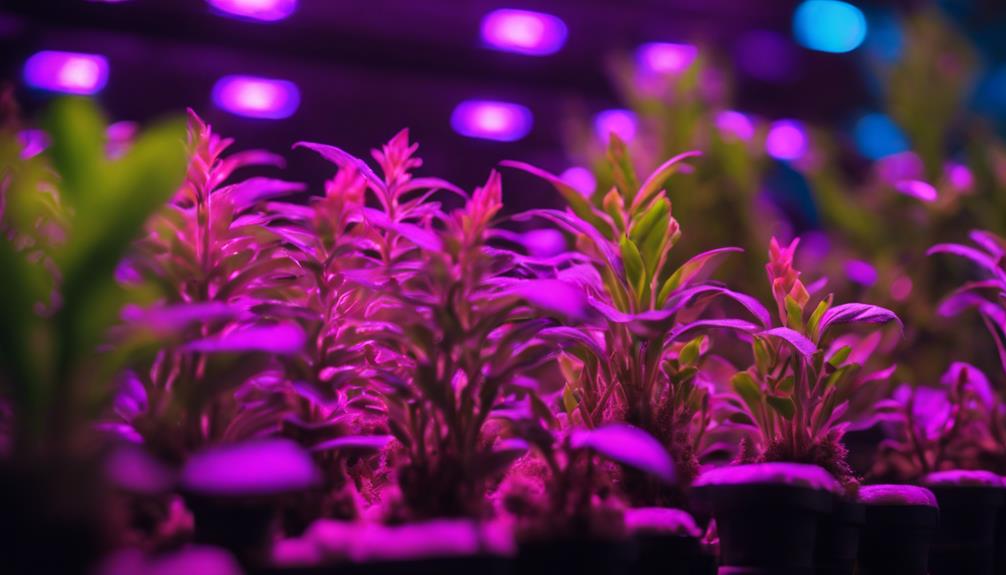
To maximize plant growth under LED lighting, it's crucial to adjust the light spectrum according to the plant's growth stage for best results. Here are some tips for using LED grow lights effectively:
- Measure and maintain proper light intensity (1000-1500 lux) to guarantee ideal plant health.
- Secure consistent photoperiods and provide periods of darkness for plants to mimic natural light conditions.
- Regularly clean LED lights and monitor temperature to create an ideal environment for plant growth.
- Experiment with different spectrums and settings to find the best combination for your specific plants.
Community Q&A

LED lighting's effectiveness in promoting plant growth has sparked various questions and discussions within the gardening community, leading to the initiation of a Community Q&A segment. Enthusiasts are curious about the specific benefits of using LED lights for plant growth, how these lights facilitate photosynthesis, and the ideal light intensity levels required for different types of plants.
Through this Q&A platform, experts shed light on the advantages of LED lights, emphasizing their ability to provide the necessary red and blue light spectrums essential for photosynthesis. Additionally, community members inquire about the energy efficiency of LED grow lights, their customization options, and suitability for various plant growth stages.
Participants seek guidance on how LED lights mimic natural sunlight, supporting healthy plant development from seedling to maturity. Scientists and plant biologists recommend LED lighting for indoor plant growth, contributing to the growing popularity and adoption of this technology in gardening circles.
Frequently Asked Questions
Can Plants Grow Under Normal LED Lights?
Plants can grow under normal LED lights, but LED grow lights are more beneficial with their red and blue light wavelengths. LED grow lights offer a wider range of colors and wattages, supporting plant growth effectively. They're suitable for all growth stages, from seedling to maturity, promoting healthy development.
Vegetables, flowers, and herbs respond well to LED lighting, yielding better results. Scientists recommend LED lighting for its energy efficiency, customizable spectrum, and cost-effectiveness.
Will Plants Grow Under White LED Lights?
White LED lights may not fully support plant growth due to their limited light spectrum. Plants require a range of light from violet to deep red for best development. Regular white LEDs emit light in a range that may not meet these specific needs.
To promote robust plant growth, specialized plant bulbs or LED grow lights with tailored spectrums are more effective options. For general lighting, white LEDs are useful, but for plants, tailored spectrums are more beneficial.
Can Plants Photosynthesize With LED Light?
Plants can effectively photosynthesize with LED light, given the right intensity and spectrum. LED grow lights provide ideal light spectrums, such as blue and red, essential for photosynthesis.
These lights mimic natural sunlight, enabling plants to convert light energy into chemical energy through photosynthesis. As long as the light intensity and spectrum meet the plants' specific requirements, they can thrive and develop efficiently under LED lighting.
Can Plants Burn Under LED Grow Lights?
Plants are unlikely to burn under LED grow lights due to their energy-efficient design and precise light distribution. LED lights emit minimal heat, reducing the risk compared to traditional options like HPS or HID.
Maintaining a proper distance of 6-12 inches between plants and LED grow lights helps prevent burning and guarantees ideal light absorption. The customizable light spectrums of LED lights allow for adjusting intensity and color to meet specific plant needs without causing burns.
Conclusion
To sum up, plants can indeed grow under LED lighting. These efficient and customizable lights provide the necessary spectrum for plant growth, mimicking natural sunlight.
With the right setup and care, plants can thrive under LED grow lights, producing healthy and vibrant foliage.
So, next time you're looking to cultivate a green oasis indoors, consider using LED grow lights for a flourishing garden that will brighten up any room like a ray of sunshine.
Lighting
Will Low Voltage Damage LED Lights: Managing Risks
Overlooking voltage risks can harm LED lights, but with the right precautions, you can ensure their longevity and performance.
Insufficient voltage management may harm LED lights, affecting their operation and lifespan. To prevent damage, it is crucial to take into account factors like voltage sensitivity, resistors, heat dissipation, and cable thickness. Thicker cables and strategic power supply placement can lower the risk of voltage drop and safeguard LED performance. Seeking professional guidance on LED selection and setup can further mitigate risks, ensuring peak brightness and longevity. By understanding these risks and implementing suitable precautions, one can safeguard their LED lighting investment effectively. More insights are available on managing LED risks effectively.
Key Takeaways
- Applying voltage below minimum forward level isn't harmful to LEDs.
- Thicker cables reduce voltage drop and protect LEDs.
- Strategic power supply points maintain consistent brightness.
- Voltage regulation devices enhance stability and performance.
- Seek expert advice to optimize LED performance and longevity.
Factors Affecting LED Light Damage
When managing the risks of low voltage on LED lights, understanding the factors that can lead to LED light damage is essential. LEDs are sensitive to voltage levels, and applying a voltage below the LED's minimum forward voltage typically doesn't harm the LED to a great extent. However, as LEDs heat up, they exhibit a negative temperature coefficient, allowing more current to flow through them, which can pose risks if not properly regulated. LEDs are often connected with resistors in series or current regulating circuits to ensure peak performance and prevent damage.
One critical factor affecting LED light damage is heat dissipation. Effective heat dissipation is vital for maintaining LED longevity and performance. Additionally, uneven current distribution, often caused by unmatched LEDs in a circuit, can lead to overheating and impact the overall performance of the LEDs. Understanding these risks and implementing proper current regulating circuits are essential steps in mitigating the potential damage that low voltage can pose to LED lights.
Calculating Cable Gauge and Length

Calculating the cable gauge and length is essential in reducing voltage drop in LED lighting systems. Thicker cables are recommended for long installations with high-power LEDs to maintain voltage stability.
Strategic placement of power supply points can help counteract voltage drop over extended distances, ensuring peak LED performance.
Cable Gauge Importance
Thicker cables play an essential role in reducing voltage drop over extended distances in low voltage LED lighting systems. When considering the importance of cable gauge in LED installations, there are several key points to keep in mind:
- Calculating the correct cable gauge is important to prevent voltage drop in low voltage LED lighting systems.
- Thicker cables help minimize voltage drop over longer distances in LED setups.
- Proper cable length calculations based on voltage, current, and resistance are necessary for ensuring excellent performance.
Length Considerations
To address voltage drop challenges in low voltage LED lighting systems, considering the length of the cables is vital for optimizing power distribution. Longer cable lengths necessitate thicker gauges to minimize voltage drop and guarantee proper power distribution. Using thicker cables or adding more power supply points can help combat voltage drop issues in LED installations. It is important to accurately assess cable length and gauge requirements for efficient low voltage LED lighting setups. Seeking expert advice on calculating cable length can enhance the performance and longevity of low voltage LED systems.
| Cable Length (ft) | Recommended Cable Gauge | Voltage Drop (%) |
|---|---|---|
| 0-50 | 18 AWG | 2% |
| 51-100 | 16 AWG | 4% |
| 101-150 | 14 AWG | 6% |
| 151-200 | 12 AWG | 8% |
| 201-250 | 10 AWG | 10% |
Using Thicker Cables for Protection
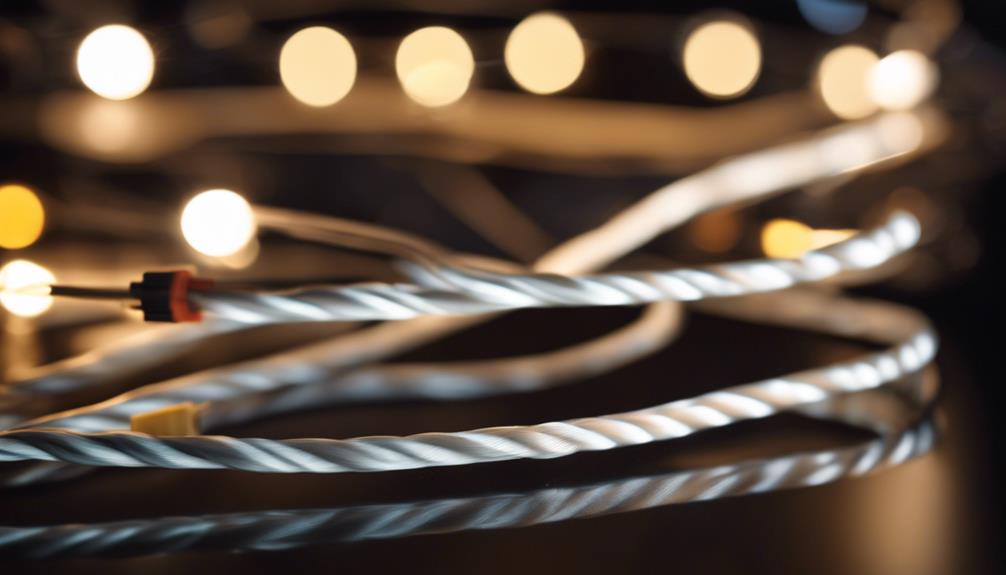
Selecting the appropriate cable gauge is essential in safeguarding low-voltage LED lights against potential damage and ensuring consistent performance. Thicker cables play a significant role in protecting low-voltage LED lighting systems. Here are key reasons why using thicker cables is beneficial:
- Thicker cables can reduce voltage drop in low-voltage LED lighting systems, maintaining steady power supply to the LEDs.
- Proper cable gauge selection helps prevent damage to LEDs, ensuring their longevity and efficiency.
- Thicker cables aid in protecting LEDs from potential overcurrent issues, contributing to stable LED performance.
Adding Extra Power Supply Points
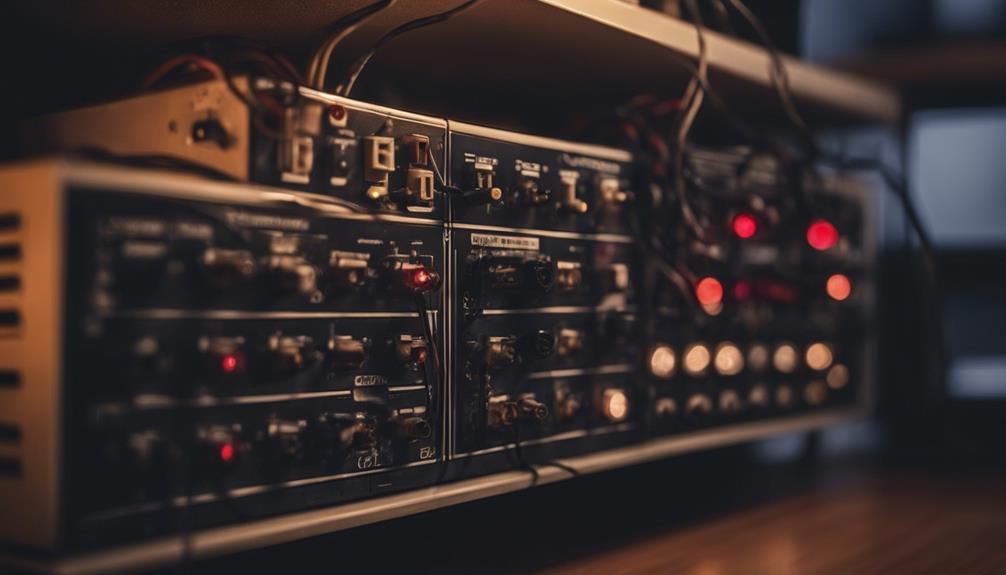
Adding extra power supply points in low voltage LED lighting setups is essential for maintaining consistent brightness levels.
Strategically placing these additional points helps regulate the voltage to guarantee peak LED performance.
Calculating the ideal locations based on cable length and LED load is key to preventing dimming or flickering issues.
Power Supply Placement
Strategically placing extra power supply points along long low-voltage LED lighting installations can effectively minimize voltage drop and guarantee consistent illumination across all LEDs. Calculating the best placement of these power sources based on the total power output and cable length is essential. Proper distribution of power supplies prevents dimming or uneven lighting in low-voltage LED setups, safeguarding the brightness and performance of all LEDs are maintained.
- Calculate the best placement based on power output and cable length.
- Ensure proper distribution to prevent dimming or uneven lighting.
- Maintain brightness and performance of all LEDs in the system.
Voltage Regulation Devices
To enhance the stability and performance of low voltage LED lighting installations, incorporating voltage regulation devices at strategic points is essential. Adding extra power supply points along the LED strip helps manage voltage drop, ensuring consistent brightness and peak functionality.
These devices play a significant role in regulating voltage levels, particularly in longer LED strip runs, to prevent issues like dimming or uneven lighting. By carefully spacing and installing voltage regulation devices, you can maintain a steady voltage supply throughout the LED lighting system.
This strategic placement not only improves reliability but also extends the longevity of the installation, providing a more reliable and durable lighting solution for various applications.
Mitigating Risks With Expert Advice
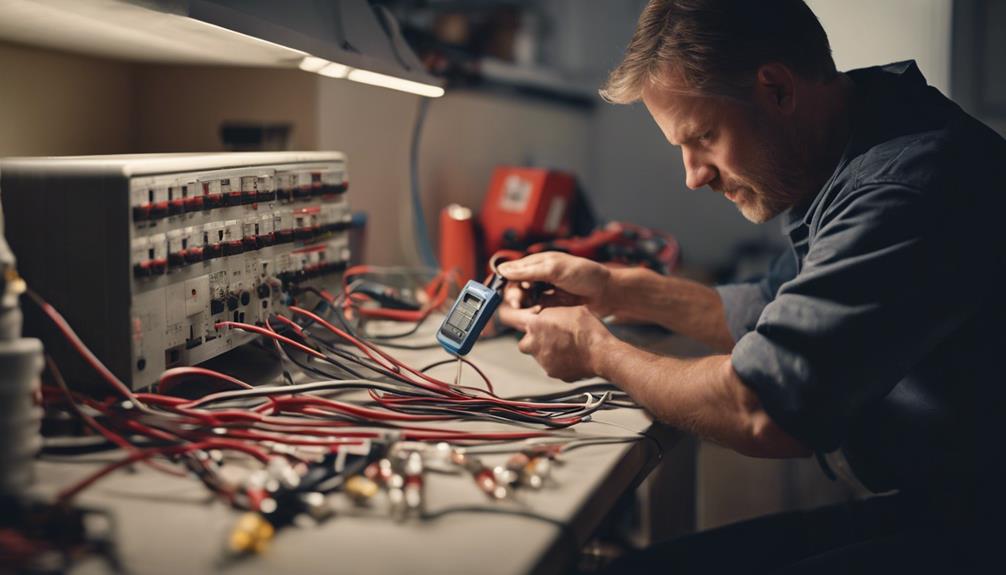
Seeking expert advice from professionals can greatly reduce the risks associated with operating LED lights at low voltages. Professionals can provide valuable guidance on selecting the right LED lights suitable for low voltage applications. They can assist in understanding manufacturer specifications to guarantee the proper selection and usage of LEDs in low voltage scenarios. Expert advice also plays a vital role in optimizing LED performance and longevity under low voltage conditions. By consulting with professionals, individuals can avoid potential damage to LED lights and maximize their lifespan in such settings.
Professionals offer guidance on selecting suitable LED lights for low voltage applications.
Experts help in understanding manufacturer specifications for proper LED selection and usage.
Consulting with professionals optimizes LED performance and longevity in low voltage scenarios.
Longevity of LED Lighting System
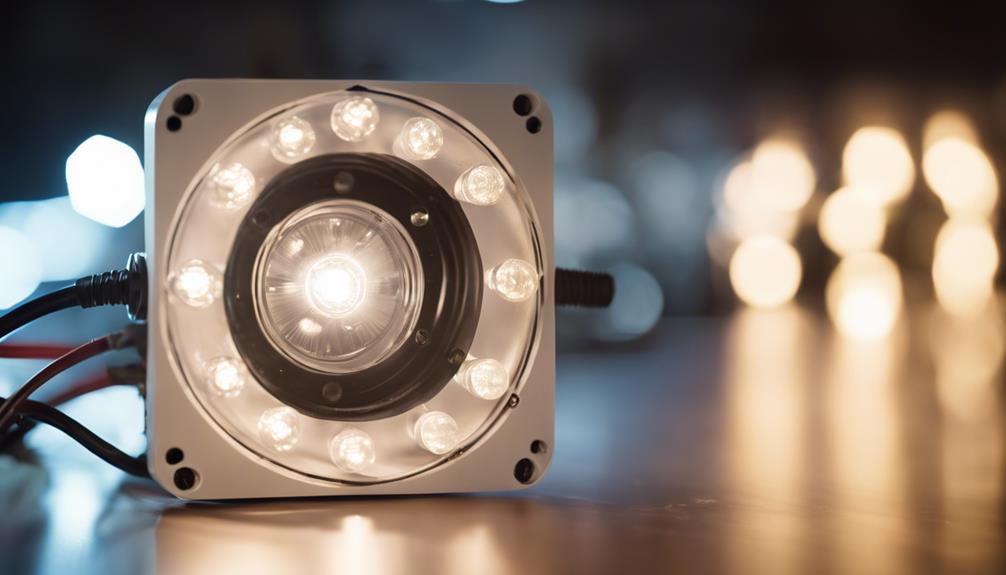
Professionals' guidance in selecting appropriate LED lights for low voltage applications can greatly enhance the longevity of the lighting system. LED lighting systems operating at lower voltage levels tend to experience extended lifespans as they generate less heat, contributing to increased efficiency.
Proper voltage management is key to optimizing the lifespan of LED lights. Choosing LEDs specifically designed for low voltage operation can further enhance the longevity of the lighting system. Consistent operation within the recommended voltage range is essential for maintaining the efficiency and durability of LED lighting systems.
Frequently Asked Questions
Can LED Lights Be Damaged by Low Voltage?
LED lights can be damaged by low voltage if the voltage falls below the manufacturer's specified range. However, operating LED lights at lower voltages within the essential safe range can actually increase their lifespan by reducing stress on the components.
It's vital to refer to the manufacturer's specifications to make sure that the LEDs aren't subjected to voltages that could cause damage. Dimmable LED lights offer flexibility and energy efficiency, even when operated at lower voltages.
What Is the Safe Voltage for LED Lights?
LED lights typically operate safely within a voltage range of 2 to 3.5 volts. Exceeding the maximum forward voltage, usually around 3.3 to 3.6 volts, can lead to LED damage.
To guarantee safe operation, constant current LED drivers regulate voltage effectively. Consulting manufacturer specifications for specific LED models is vital to determine the appropriate voltage range.
Proper voltage management is key to preventing overheating and premature LED failure.
Is 12V Too Much for LED Lights?
Operating LED lights at 12V is generally safe and within their specified limits. LED lights are designed to handle a range of voltages, including 12V, without damage. Properly regulated 12V power sources can provide excellent performance for LED lights.
In most cases, 12V isn't too much for LED lights, as it's a common voltage used for low-voltage LED lighting systems due to its compatibility and efficiency.
What Happens if You Undervolt a Led?
Undervolting an LED can result in dimmer light output, reduced brightness, flickering, and color accuracy issues. LEDs may not reach their full efficiency and performance potential when operated below their specified voltage range.
Premature failure and decreased lifespan are common outcomes of using low voltage with LEDs. It's important to adhere to the recommended voltage range to guarantee functionality and longevity of LED lights.
Conclusion
To sum up, safeguarding LED lights against low voltage damage requires careful consideration of cable gauge, length, and power supply points. By taking proactive measures such as using thicker cables and seeking expert advice, the longevity of the lighting system can be guaranteed.
Just as a sturdy ship navigates turbulent waters with a skilled captain at the helm, proper planning and maintenance are essential to steer clear of potential risks and illuminate the path ahead with brilliance.
-

 Decorative Throws2 weeks ago
Decorative Throws2 weeks agoIs It Better to Dry Clean Blankets?
-

 Yarn2 weeks ago
Yarn2 weeks agoIs Yarn Natural or Manmade? Unravel the Truth
-
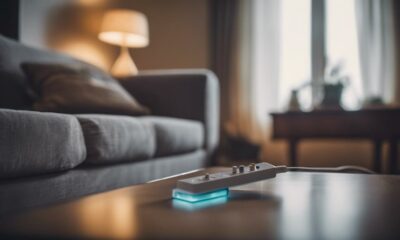
 Decorative Throws2 weeks ago
Decorative Throws2 weeks agoWhat Wattage Is an Electric Throw
-

 Decorative Throws2 weeks ago
Decorative Throws2 weeks agoCan I Use a Throw Blanket as a Rug
-

 Yarn2 weeks ago
Yarn2 weeks agoUnravel the Mystery: Why Are Yarn Specs a Secret?
-

 Craft and Textiles2 weeks ago
Craft and Textiles2 weeks ago15 Best Battery-Powered Leaf Blowers for Effortless Yard Work
-

 Tableware and Dining Accessories2 weeks ago
Tableware and Dining Accessories2 weeks agoWhat Is the Meaning of the Word Tableware
-

 Craft and Textiles2 weeks ago
Craft and Textiles2 weeks ago15 Best Toast Recipes to Start Your Day Right














